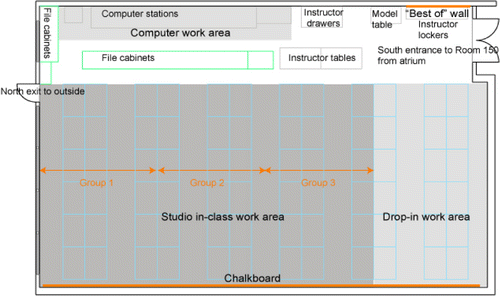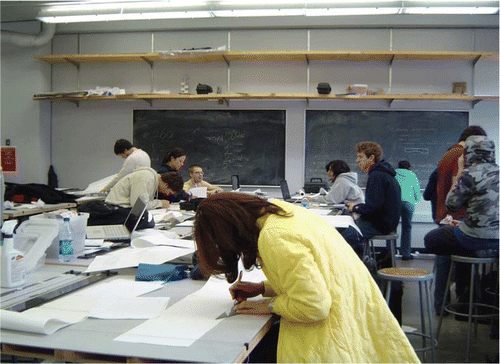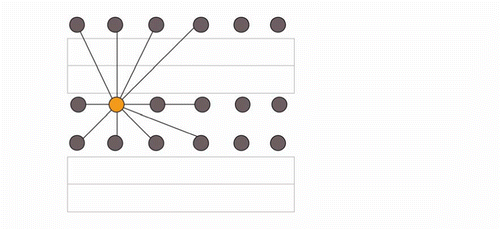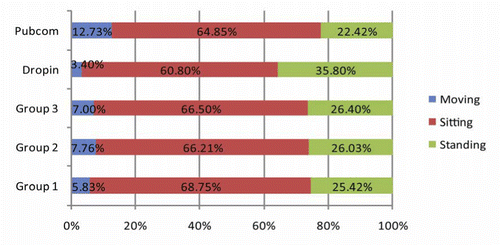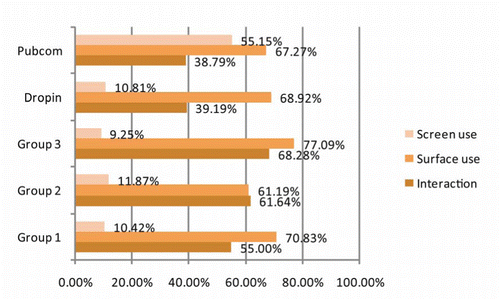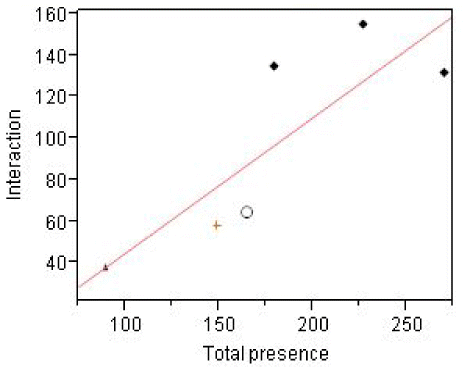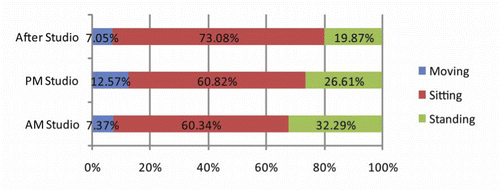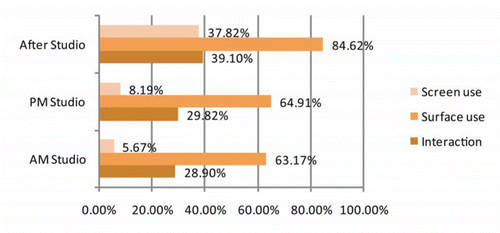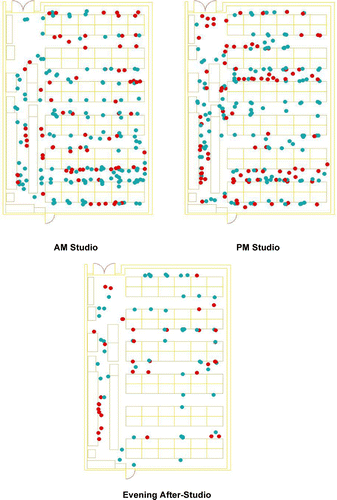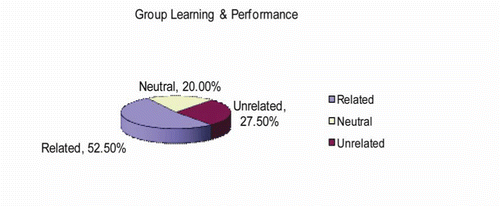Abstract
This paper uses the Common First Year Studio at Georgia Institute of Technology as an example to explore the impact of the physical environment, specifically the hot-desking studio, on communication, studio culture, and learning. The focus of this explorative research is to describe how a hot-desking studio space is actually utilised, where and how students communicate with each other, how knowledge possibly transfers among students, and the resultant students’ perception of a learning community. We have collected both qualitative data through a one-year ethnographic observation and quantitative data through behavioural mappings and questionnaires. The results show that the hot-desking studio provides opportunities for informal interactions both within and across groups. It can help formulate the sense of community at the group level instead of at the individual level. Hot-desking studios also present some challenges to first year design students, since they rely heavily on physical presentations for knowledge transfer. To make up for the lack of work surfaces, displays and artefacts should be placed wisely to help in transmitting knowledge in hot-desking studios. Limitations of the research design for this study and implications of the research findings for future studio design are discussed.
Introduction
Motivation: changing studio
Studios have gone through many changes in the past decade, in facing the challenges of increasing student numbers, pressure on space and staff time, transition of students’ life and work pattern, and rapid change of technology. Some studios react to the challenges with changes in pedagogies. For instance, they take studios outside, and link creative designs with real-life community design problems (CitationMorrow, 2007). Many other studios respond with new space management strategies, e.g. applying the hot-desking policy.
The hot-desking studio is based on a mobile work pattern. Students have no fixed space for personal workstations and use any available desk during a certain session. The hot-desking arrangement originated as a trend in the late 1980s in office designs as an approach to save space and other resources, and to allow more flexible staff working hours. Based on a systematic literature review on office design, CitationDe Croon et al. (2005) claim that desk-sharing in office use can improve communication. On the other hand, there are complaints about hot-desking space regarding its lack of privacy and personal territory (CitationGorgievski et al., 2010). However, most of the studies reported have been carried out in office settings. Few studies have undertaken systematic investigations of the link between the physical environment, studio culture and its embodied behaviours under hot-desking conditions. Hence, it is particularly important to observe, document and reflect how studios are used under the new spatial and temporal constraints; and to explore the behavioural consequences of the fluidity, variety and transformability of the studio learning environment. In this paper, we would like to use the Common First Year Studio at Georgia Institute of Technology as an example to explore the above issues.
The setting: the hot-desking Common First Year
The Common First Year (CFY) in the College of Architecture at Georgia Institute of Technology is the first year studio that all freshmen have to proceed through before entering one of three undergraduate programmes: Architecture, Building Construction, and Industrial Design. Around 95% of the CFY students do not have any previous experience of studio. The CFY studio offers an opportunity for students to understand different disciplines during the first year and figure out their own interests before they finalise the majors in sophomore. Another mission of the CFY is to help students to be better prepared to work collaboratively and productively with peers across disciplines.
The CFY studio has been running for 12 years. When the College of Architecture first decided to combine freshmen from three different majors into the Common First Year, the limited physical space became a challenge. Students were scattered around the College since they used to belong to different majors. A communal space was needed for truly integrated and collaborative multidisciplinary learning. The College of Architecture decided to use Room 150 in the West Architecture building at Georgia Institute of Technology as the common studio for all CFY students. The area of the studio is about 254 sq meters (2734.45sq ft).
Around 200 students are enrolled in the CFY studio each year. In order to resolve the conflict between the limited space and the large number of students, the hot-desking policy is adopted from the very beginning of the CFY studio. The use of studio space is arranged into four time slots, Monday/Wednesday morning session from 8:30 to 13:00 (A), Monday/Wednesday afternoon session from 13:30 to 18:00 (B), Tuesday/Thursday morning session from 8:30 to 13:00 (C), and Tuesday/Thursday afternoon session from13:30 to 18:00 (D). For each time slot, there are usually three groups each led by one instructor. Each group is assigned with a distinct name, which is a combination of the time session and group number. For example, A1 represents group one of the Monday/Wednesday am session. Students register studio sessions by group names. They are required to come to studio during the assigned group studio time. They can also come in to work at a specific ‘drop-in’ work zone during their off-studio time. All students are required to clean up the working surface before they leave the studio at the end of each work session. The utilisation of space becomes temporary and the studio society becomes ‘nomadic’.
In order to meet needs from different users, Room 150 is divided into multiple functional zones, such as the in-class work area, the drop-in work area, the public area composed of computer stations and flat file cabinets ( and ). Three quarters of the space is reserved for the in-class studio groups. Each group usually takes three rows of desks, since one group has about 12–16 students. Students from each group are free to choose any desk within the range of their assigned group area. Another three rows of desks are set aside for the CFY students who ‘drop in’ to work during their off-studio time. Instead of clustering all desks from one group together, every two rows of desks are arranged to face each other, with aisles behind each row. The CFY studio is based on an open-plan, where there is no physical barrier between desks. The public computer area is separated from the rest of the room by a row of high flat file cabinets, where all CFY students store their drawings. Any CFY student can use the public computer stations at any time. The overall spatial allocation is intended to bring students in contact with others on a random basis and maximise communications.
Another important feature of Room 150 is the vertical information display. On the western wall behind each row of desks, there are chalkboards for instructors to write down some key contents of tutorials. The information usually stays across different time sessions and becomes a shared knowledge repertoire. On the eastern wall near the main entrance from the atrium, there is another display wall of best work. After each studio class, instructors put up the best work of their sessions to the ‘best of’ wall and share them with the entire CFY.
Figure 2b Drop-in working area
Some students from other time sessions drop in and work on their homework
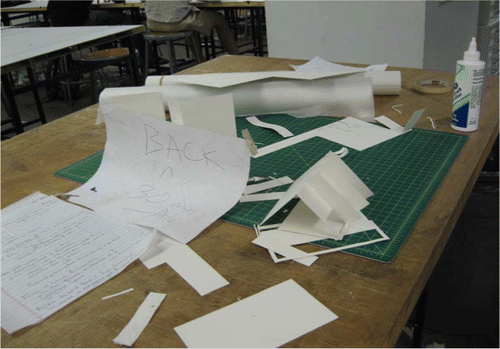
Figure 2c Public computer area
The computer stations are occupied by students from various time sessions
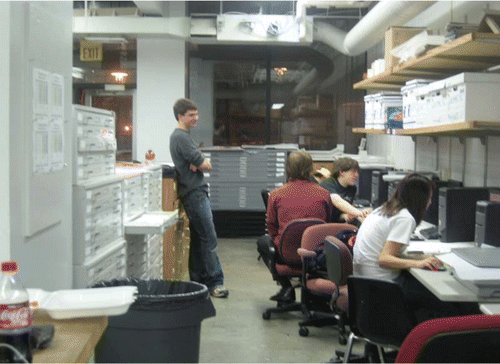
Room 150 is mainly used for short tutorials, desk-crits, and students’ workplace. Due to space limitations, most of the pinups, group crits and formal reviews are held in the atrium space outside Room 150. The authors acknowledge the importance of group review in studio learning. However, in this study, we are interested in the role of the physical environment of the studio in facilitating informal communication. The instructors and critics drive most of the conversations during review. There are seldom informal conversations among students driven by space and encounter. In addition, within Room 150, it is hard to track the changes of the pinup space consistently, since for each review the space is formed temporarily by some movable panels in the atrium.
The CFY studio also has a virtual environment named ‘CoOL (Collaborative On-line) studio’ to facilitate information exchange and strengthen the group bond. It is an interactive website where instructors can post handouts, schedules, precedent cases and students can articulate their reflections on each exercise. Detailed descriptions of the virtual environment of CFY are available elsewhere (CitationZimring et al., 2001). Despite the importance of virtual environments, the focus of this paper is on the role of physical environment on interactions and learning.
Literature Review
Similar to the CFY at Georgia Institute of Technology, many current studios are facing the pressure of limited physical space and moving into the hot-desking age. In order to understand the theoretical link between physical environment, learning and studio culture, we examined literatures from different disciplines, including architectural pedagogy, learning theories, organisational culture, and the space syntax theory. Through integrating the ideas from various disciplines, we developed our hypothesis on the characteristics of a positive studio environment that supports learning.
What is the nature of studio learning?
Traditionally learning is classified as explicit learning and implicit learning (CitationReber, 1967, 1993). This classification aligns with CitationRyle’s (1949) distinction between ‘knowing that’ and ‘knowing how’. According to CitationPeter Rowe (2002, p.25), professional design education is fundamentally about conveying a combination of ‘knowing how’ and ‘knowing that’, which he refers to as ‘actionable knowledge’. Studios are important ‘hands-on’, ‘learning-by-doing’, ‘side-by-side learning’ settings to provide knowledge of ‘knowing how’. The implicit knowledge is acquired through extensive involvement with the environment, where the appropriate actions and rules can be learned (CitationReber, 1993). In addition, CitationDonald Schön (1987) has stated in his book The Reflective Practitioner that studio learning is based on ‘reflection-in-action’, ‘critical reflection on practice’, and ‘interpersonal skills’. In studio education, the process of students critiquing one another and collaborating on group work is as an equally important component as the final product (CitationSalama, 2005). Effective studio learning happens in an open, interactive environment that encourages communication, reflection, and collaboration.
Furthermore, the repertoire of architectural knowledge is built up through a collection of images, ideas, examples, actions and conversations that the students or practitioners can draw upon. It is similar to what CitationHutchins (2001, p.2068) defines as ‘distributed cognition’. He claims that:
cognitive processes may be distributed across the members of a social group, cognitive processes may be distributed in the sense that the operation of the cognitive system involves coordination between internal and external (material or environmental) structure, and process may be distributed through time.
CitationNewstetter et al. (2004, p.T1A-3) use another term ‘agentive learning’ to explain the important role of artefacts in learning. ‘Agents’ include both human and nonhuman artefacts, such as devices and physical entities. They claim that constructing strong social relationships is important in gaining a wealth of problem-solving capacity and knowledge acquisition. The newcomer has to develop the ability to identify and go to the right person who has the specific knowledge. In that sense, an effective studio space is an environment that contains rich visual information and supports active informal communications to facilitate the transmission of tacit knowledge among different ‘agents’.
Studio culture as ‘hidden curriculum’
Studio culture has long been recognised as an important factor in promoting creative and collaborative activities among design students (CitationKoch et al., 2002; AIAS Studio Culture Task Force, 2004; Centre for Education in the Built Environment, 2003). According to the AIAS Studio Culture Taskforce Report, the most valuable studio culture characters are ‘the sense of community’, ‘peer support’ and ‘peer-to-peer learning’ (CitationKoch et al., 2002). Studio culture can promote learning based on continuous dialogue and conversations among students (CitationFallman, 2007).
The design studio provides a context where students acquire not only the knowledge and skills, but also the standard rules and the new field of language and communication (CitationSimmons, 1994). Some researchers call studio culture the ‘hidden curriculum’ of studio learning. In simple terms, the hidden curriculum refers to those values, attitudes, and norms that establish upon both the curriculum and the social interactions (CitationDutton, 1991). Studio works as a physical and social environment where the embedded values of architecture are transmitted and social relationships between students, tutors, and peers are constructed (CitationDatta, 2007). Different physical designs of studio environment, including layout, furniture, and displays can foster various patterns of interactions, hence shape specific types of studio culture.
Physical environment and studio culture
However, few studies have explored the relationship between the physical environment of studio, learning and studio culture. In an effort to redesign studio space to support studio culture, CitationFallman (2007) claims that the studio should be a natural setting for people to interact with each other and to promote creative and collaborative activities. In addition, the studio should support multiple needs and styles of learning, both for collaborative studio work and personal reflection. The resulting new studio includes the private individual workspace, a semi-private space, known as the ‘war room’ for group work, and a ‘kitchen space’ as a public space to host events related to outside clients and guests.
Physical environment and organisational communication
Some studies from organisational communication do provide insights on the relationship between the physical environment, communication, and learning. The researchers acknowledge the importance of face-to-face communication in building social bonds, facilitating information exchange, and dissemination of knowledge (CitationBecker and Sims, 2001; Nardi and Whittaker, 2002). They view certain work environments as an affordance or ‘opportunity’ to overcome social and organisational barriers, and enhance communication. For example, more open work areas with a high degree of visual contact have been shown to be more effective than more closed offices and workspace by providing an environment for free exchange of information and opinions, as well as enhancing a better understanding of others’ skills and knowledge (CitationBecker and Sims, 2001). Studies have also shown that the length and strength of interactions among office workers are influenced by their physical proximity (CitationAllen, 1970). More interestingly, innovative problem solving is generated through the communication between people working on entirely different projects instead of within the same project team (CitationAllen, 1977).
CitationFrancis Duffy (1974) is one of the most influential scholars who has related sociological dimensions of organisations to physical properties of office design. He points out that organisations can be characterised by different kinds of work patterns that combine different levels of autonomy and interaction. Knowledge work demands open-ended, spontaneous interactions, which can be supported by a space with few differentiations and subdivisions (CitationDuffy, 1974; Duffy and Powell, 1997).
The Space Syntax scholars have linked specific office layout variables, such as visibility and accessibility, to spatial behaviours, including movement, physical co-presence, awareness, and unplanned interactions (CitationGrajewski, 1993; Hillier and Penn, 1991; Penn et al., 1999; Peponis et al., 2007; Rashid and Zimring, 2003; Rashid et al., 2006; Serrato and Wineman, 1999). The basic premise is that spaces with higher visibility and accessibility have more natural movement. Movement can then contribute to encounter and informal communication, which in turn facilitate the transmission of knowledge. For example, CitationPenn et al. (1999) find that movement generated by the space configuration directly affects the frequency of contact and communication between workers. CitationRashid et al. (2006) find that the co-presence is highly correlated to interaction. A well-connected local network where users can see and reach each other easily is usually a predictor of a strong sense of community (CitationWineman and Adhya, 2007).
In summary, this studio approach is based on implicit learning, which requires learning by doing and reflection in action. In addition, studio learning is a collective behaviour.
Knowledge is distributed not only among artefacts, but also among people. The space for a positive studio culture should be a setting that encourages people to encounter and interact with each other naturally, and support various ways of learning, both on the individual and collaborative level in small groups. Openness, proximity, accessibility, and visibility are important features of the physical environment that can affect face-to-face communication and tacit learning in studio.
Research Questions
The case study, sought to find out the relationship between studio space, communication, and learning. More specifically:
How do students use the studio space under the hot-desking policy?
How do the patterns of use vary by space and time?
What is the relationship between behaviours such as movement, co-presence, use of screen, use of computer and communications?
What is the role of physical artefacts and displays in studio communication and learning?
Research Method
In order to understand fully the complex and ambiguous nature of communication and learning under hot-desking conditions, we conducted an exploratory empirical study in the CFY at Georgia Institute of Technology. We used a multi-layered approach, combining qualitative and quantitative methods, to document and evaluate behaviours related to space. Qualitative approaches included a non-intrusive ethnographic observation. The quantitative approaches applied behavioural mappings to document how students used the studio space and students’ perceptions of the learning community were collected via questionnaires.
Observation
A basic understanding of the space use was obtained through a one-year ethnographic observation. We kept a research diary to document everyday events of the CFY studio, not only the activities related to the physical environment, but also the subjects and artefacts presented in the space. It provided us with a macroscopic understanding of both the curriculum and the related use of studio space.
Behavioural mapping
Behavioural mapping has been widely applied in behavioural studies in many settings such as offices, labs, hospitals, and museums. It is a type of systematic observation method that tracks behavior over space and time. It can link certain behaviours with the physical locations where those activities happen. Behavioural mapping does not record blindly all activities but rather a limited set of behaviours. In this study, we pre-defined the categories of activities and coded them as S (Sitting), T (Standing), and M (Moving). Their status of interaction, and the use of work surfaces and screens was also recorded. The identity of people was coded as I (Instructor), and S (Student). We developed symbols to represent the combination of identity and activities (see ).
Figure 3 Example of one round of behavioural mapping with legend
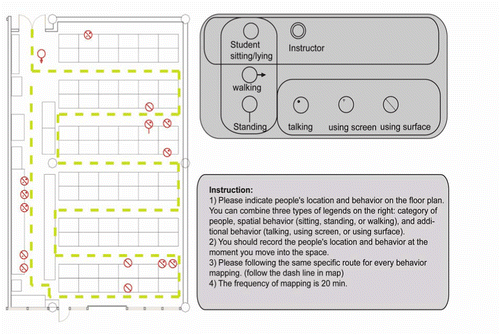
For instance, if a student was walking while talking to another student, we represented him as a circle with a solid dot in it and an arrow attached. For each behavioural mapping, we held a printed studio plan at hand, walked through the studio via a standard route, and documented physical locations and activities of all those present in the studio. It was similar to taking a snap shot of how the studio was used. Each cycle of behavioural mapping took approximately 20 minutes. Each hour of observation resulted in three sets of behavioural mappings. We chose to observe three different time sessions based on the morning studio (8:30–13:00), the afternoon studio (13:30–18:00), and the evening after-studio session (18:00–22:00). During February 2008, we conducted 12 hours of observation, four hours for each time session. The observations were not consecutive. Instead, they were carried out on different days over a month’s period. We are not assuming that behaviours on different days would be the same. Admittedly, continuous observation for 12 hours would be more desirable than a composite of separate observations, if the purpose was to reconstruct a day in the life of the CFY studio. However, the main purpose of behavioural mapping here was to obtain a generic pattern of space use. Having mappings from different days might reduce the bias of special events of one specific day.
In all, 36 sets of behavioural patterns and 1,027 events for 192 participants were recorded. For the purpose of data analysis, we transferred the symbols into the Arcview GIS database and represented the status of using surface, using computer, and interaction as ‘true/false’ accordingly. For example, students who interacted were recorded as ’true’ and those who did not interact were recorded as ‘false’ (see for a small part of the database as example). The database allowed us then to conduct multiple statistical analyses later.
Table 1 A small set of the Arcview GIS database of behavioural data
Survey
In order to get students’ subjective feedback about the physical environment and studio learning, we developed a set of questionnaires and handed them out to students (see Appendix for the questionnaire). The survey was divided into two parts. The first part aimed to collect students’ feedback on the quality of the studio environment and the related learning. We asked the students to scale their perception between the environment and learning community in the CFY based on a five-point Likert scale. Due to a broader interest, our survey included both the physical and virtual environments. However, in this paper, we only discuss the results related to the physical environment. In addition, we asked the students whether they thought the learning performance for architecture students was related to group learning and we asked them to rate the relevance.
The second part of the survey was adapted from a survey used by CitationPeponis et al. (2007) in a study about knowledge environment in an R & D firm. They had succeeded in using the survey to find out whether space can contribute to informal communication, thus spreading specialised knowledge among people with different kinds of expertise, experiences and skills. The survey had four sections. The first section was composed of three questions related to the students’ awareness of their peers’ work. The second section was composed of six questions related to whether the CFY studio space supported the communication, interaction and collaboration among students. The third section focused on the application of technology in the CFY studio in supporting teamwork and collaboration. The final section was associated with the sense of personal territory in the CFY.
Results and Discussion
In this part, we analyse the data we collected from the case study and develop the discussion around the issue of physical environment, interaction and learning in the CFY studio.
Observation
One interesting finding from our observation is about the spatial hierarchy demonstrated by the use of circulation and space. Most students use the corridor between the file cabinet and studio desks as the major circulation route. The corridor between the computer stations and the file cabinets is less frequently used as circulation. Circulations in this corridor are mostly function driven, i.e. to use the computers, to retrieve or store drawings and other supplies. The aisle in front of the chalkboard is scarcely used by students for circulation purposes. Even though the design of the studio is open-plan, the use of space does demonstrate the differentiation of functional zones.
We also recognise the importance of artefacts and display in exchanging information in the CFY studio. The ‘best of’ wall is an important learning medium, where students usually spend some time to get updates of other groups’ work and learn from each other. The chalkboard is used in multiple ways. Instructors use the board as a way to communicate key information to their students. The byproduct is that instructors can learn from each other, through reading the notes left by other instructors. Students sometimes use the board as a place to exchange their feelings about studio, almost in a form of graffiti. It indirectly demonstrates the needs of personal expression due to the lack of personalisation of space in the hot-desking studio.
Based on our observation, physical adjacency and visibility may affect the frequency of interactions. Interactions often happen between students who are no more than three seats apart ().
The non-division open-plan and collocation of different groups seem to support a wide range of face-to-face communications and the flow of knowledge. The random seat arrangement within the group allows students to be exposed to different neighbours’ work and interact with more peers. In addition, the non-ownership of the hot-desking space supports flexible team collaborations. During a collaborative project, group members can easily re-arrange their seats to stay close to each other, thus promoting communication and information exchange.
Behavioural mapping analysis
Behavioural mappings provide a more objective reading of the use of space. The 36 sets of data were used to compare the distribution of different activities such as sitting, standing, moving, interacting, using screens, and using work surfaces (see ).
During 12 hours of observation, only a small percentage (9.2%) of students exhibited movement. Most students were static, either sitting (63%) or standing (27.8%). Most of the students in the setting were engaged with work surfaces (68%) and only a few of them (18%) used computers. The interaction rate, in other words the ratio of students who interacted versus the overall number of students, was 34%. More importantly, more than half of the interactions were accompanied with use of work surfaces (59%) and very few were accompanied with movement (4%). This behavioural pattern was consistent with the nature of beginner education in architecture. The curriculum in the CFY focused on both technical skills and cognitive understanding of hand drawing and its connection to design. The computer was not encouraged as a design tool, but was mainly applied as a documentation and information-seeking tool. As freshmen in architecture who lacked the set of norms and domain knowledge to aid their communication, they had to use the artefacts on the work surface, such as drawings or models, to facilitate communication and knowledge transfer.
Table 2 Overall number and ratios of different activities
In this section we further categorise all activities based on space and time. For instance, the behaviours are mapped to zones of ‘in-class group 1’, ‘in-class group 2’, ’in-class group 3’, ‘drop-in’, and ‘public computer’. We compared the percentages of moving, standing, sitting, interaction, work surface use and screen use across different zones ( and ).
Groups 1, 2 and 3 showed similar behavioural patterns which can be explained by the similarity in their programmes. There are more movements in the public computer zone than the drop-in zone and in-class group zone. The reason might be that the public storage of students’ work is located in the public computer zone. Students have to go through the public computer zone to retrieve or store their work. The drop-in zone has the lowest movement ratio, since it is located closest to the entrance and there is no other reason for other students to walk through this area if they are not working there. It shows that the placement of ‘activity nodes’ such as storage and break area might affect the frequency and distribution of movement.
Surface use is evenly distributed among different zones. In each zone, there are more than 60% of students using work surfaces. The rate of screen use is only high in the public computer zone, which again reflects that the focus of the CFY curriculum is on hand drawn skills. When we compare the interaction ratio, there is a difference between in-class zones, the drop-in zone, and public computer zone. In-class group zones generally have quite a high interaction ratio. More than 55% of the students interact during their studio work. In the drop-in zone and the public computer zone more than one third of users interact with each other. Although the interaction ratios in these two zones are not as high as in-class group zones, the communications are quite valuable. They are the interactions outside the student’s immediate group, which can possibly lead to innovative solutions to the problems at hand. This is supported by our observation. One student learned how to create a horizon line in a viewfinder to help his perspective drawing when he worked in the drop-in area and talked to a student from a different group.
We further test the relationship between movement, co-presence and interaction. We find that in the CFY studio, co-presence is a good predictor of interaction ratio, R2=0.69 and p<0.038 (). That means that seeing more peers present in the same space can lead to higher possibilities of interactions. Hence, the openness and visibility may influence the interaction and transmission of knowledge. Although movement is not directly correlated to interaction, movement does expose students to different ‘agents’ of knowledge, including other students, work in progress, and displays etc.
We also look at the behaviours by different time sessions, i.e. the ‘AM studio’, the ‘PM studio’ and the ‘evening after-studio’. Although the number of users decreases during the evening after-studio session, the percentage of movement, sitting and standing stay constant across three time sessions ().
More interestingly, during the evening after-studio session, the use of screen and work surface both greatly increase (37.82% and 84.62% accordingly). The interaction ratio also increases to 39.10% ().
When we map the communications to space, we find different patterns presented between the AM, PM studio sessions and the evening after-studio session (). During studio sessions, the communications are driven by the class schedule and programmes. The interactions are mainly within-group interactions. During the evening after-studio sessions, the communications are more spontaneous and space driven. The interactions are mainly across-group interactions. Students tend to locate themselves according to their different needs for private work, social interaction and knowledge transmission. The public computer area becomes the most concentrated social interaction hub. The reason might be that the high file cabinets help define a semi-enclosed zone, where students feel more comfortable to communicate without interfering with others’ work. In the area where all the drawing desks are, the number of students present and interacting drops substantially with the increase of depth from the main entrance.
By examining the behavioural mapping data, we are able to see where the interactions occur, whether the frequency of interaction is related to the presence of surface/screen, the correlation between interaction, movement and co-presence. Most importantly, we can map the interaction patterns in the layout, and correlate the interactions with spatial properties.
Survey analysis
To get the students’ subjective perceptions on the CFY studio environment, we handed out 50 copies of survey forms to the students and received 40 replies: the return rate was 80%. For the first session, the responses show that most students (65%) believe that the physical environment is related to their sense of community; 27.5% of the students think it is not related to the sense of community (20% of the respondents rate the environment as somewhat unrelated and 7.5% rate it as very unrelated).
In terms of their perceptions about the relationship between group learning and design students’ learning performance, over half of them (52.5%) think it is related (17.5% very related and 35% somehow related). The results show that most of the students acknowledge design education as a special type of collective learning, which is built upon group learning and peer-to-peer learning (). In addition, they recognise the physical environment as an important repertoire of knowledge.
The second part of the survey focuses on the students’ feedback with regard to the physical environment and their perceived social support. The first set of three questions concerns peer-to-peer awareness and the related feel of social support. The results show that almost all students agree on the importance of the awareness of peer’s work and peer support (90% and 97.5% correspondingly). They also report that they have very high awareness of peers’ work in the studio (97.5%).
The second section solicits feedback on how the studio has supported students’ interaction and communication amongst each other. The results are quite encouraging as most of the students think that the design of the CFY studio is supportive for them to exchange ideas with each other (92.5%). A high percentage of students (85%) report that they frequently have ‘hallway’ conversations with their peers. About 72.5% of students claim to have access to spaces for unplanned meetings and 55% of students report to have teamwork areas when they try to schedule a meeting.
The third section is about whether the technology in the CFY studio can support their access to information and collaboration with each other. More than half of the students (55%) show a positive attitude on the provision of technology in the studio as a supportive tool.
However, the final few questions about their perceptions of personal territory in the CFY demonstrates some insufficiency of the current CFY in supporting individual private work. Although most of them (70%) state that they prefer to use the same table whenever they can, only 10% of the students show that they are able to use the same table when they are working in the CFY studio. Only 15% think that their personal workspaces had few distractions.
Overall, students believe that physical environment is important in supporting the learning community and improving their learning performance. The current open-plan hot-desking CFY studio is perceived to be supportive for shared-awareness of peers’ work and information exchange. However, the results also reveal a lack of personal territory and ownership in the hot-desking CFY environment. It makes space management and furniture maintenance difficult.
Discussion
Taken together the qualitative and quantitative methods give rise to a diverse and multi-layered ‘rich’ description of the CFY studio from both first and third person perspectives. The results show that learning in the architecture profession has a collective dimension. In the studio setting, learning often takes place in teams. It is enhanced by communication and collaboration among individual members and groups. The knowledge pool is based on a shared repertoire of communal resources, including artefacts, vocabulary, displays, and people. Proximity, visibility, placement of activity nodes such as break room, storage, and computers affect the distribution of movement, and resulting communications and exposure to ‘agents’ of knowledge.
The observations and behavioural mappings also help depict the dynamic space use in the hot-desking CFY studio. Based on the analysis of activities by space and time, we discover that a studio environment is able to support a variety of students’ needs. For a positive learning community, it is as important to encourage peer awareness, social interaction and communication to support personal territory and self-reflection. The current open-plan CFY studio is effective in facilitating both within-group and cross-group communications. The nomadic style of studio use increases the chances of encounter and interaction between students, and therefore leads to a better dissemination and generation of knowledge. However, it is weak in creating an environment where students can concentrate on individual work and establish personal identity.
Another implication of hot-desking is the ‘clean’ desktop. Students have to remove all the ongoing work by the end of each session and start from scratch next time. On the one hand, it is positive to have a clear desktop to help students start fresh. It also makes the reviews more fruitful, since it is the first time that students get to see the complete image of his/her design at once. Students are more engaged in the reviews in the new context. On the other hand, the ‘clean’ desktop has several disadvantages. Firstly, students do forget what they have done. It is a challenge to ask students to look back and relate to their previous work when there is a shortage of physical display. Presence of work can remind students of the journey they have travelled, enhance the continuity of work, and reduce their cognitive load. In addition, the role of artefacts (models, drawings etc.) as ‘agents’ of knowledge is diminished.
Just as in any other types of physical environment, a studio environment should be designed to fulfill the needs of its specific user group. One lesson we learn is that a hot-desking studio might not work as well for first year design students as for upper year students. Based on our behavioural mappings, most interactions in the CFY studio are attached to work surface use. It is decided by the nature of the beginner education in architecture. They have not formed their ‘domain language’ to communicate on the fly yet. Many conversations have to be developed around the artefacts and within the context. For beginner students, it is rather important to be surrounded by their best work, as the first year studio is a process of building the ‘toolkits’ of professional skills and languages, and their design confidence. In addition, the studio is particularly important for first year students in forging a sense of belonging and identity (CitationDuggan, 2004).
In the face of the hot-desk situation, both the programme and the design of physical environment have to be shifted to a new paradigm. The role of the studio has to be redefined as a hub of communication, collaboration and innovation. At the same time, efforts are required to manage the limitations of the time-limited studio space use. Under the transient environment of the hot-desking studio, it is important to use artefacts/displays wisely to sustain and distribute knowledge.
Contribution and Future Work
This study provides a comprehensive description of a hot-desking studio space and users’ behavioural patterns through multiple methods, including observation, behavioural mapping and survey. This study introduces behavioural mapping as a method to support a quantitative measure and evaluation of the space use of the CFY studio. The standard objective mapping allows us to eliminate some possible bias of the observers. The systematic approach also allows other researchers to repeat similar studies in other studios and accumulate the knowledge of communication and learning related to the studio environment. The visualisation of behaviours in space also helps school administrators and architects understand the space utilisation, the distribution of interactions related to space, even the spatial factors that contribute to communication and active learning in studio. This study serves as an example of providing rich data as evidence to support decision-making, and therefore achieve better management and design of a ‘student-centred’ studio.
Due to the explorative nature and the descriptive design of the study, it is not possible to compare the communication and learning between the hot-desking studio and the traditional studio. We cannot draw any causal relationships between built environment and learning outcomes through this study. More rigorous quasi-experimental studies, such as pre-post hot-desking studies and case-control studies are needed. They may help to establish the link between the physical environment of studio and learning outcomes, and thus provide reliable evidence for future studio design.
Acknowledgement
The authors acknowledge the support of the Common First Year course coordinator, Mrs Ann Gerondelis, and extend gratitude to all Common First Year students and instructors who participated in the study.
References
- AIAS Studio Culture Task Force. (2004). The studio culture summit. University of Minnesota: AIAS (American Institute of Architecture Students)
- Allen T. J. (1970). Communication networks in R&D laboratories. R & D Management, 1 (1), 14-21.
- Allen T. J. (1977). Managing the flow of technology. Cambridge, MA: MIT Press
- Becker F. D. & Sims W. (2001). Offices that work: Balancing communication, flexibility and cost. Ithaca, New York: Cornell University International Workplace Studies Program.
- Centre for Education in the Built Environment. (2003). Studio culture: Who needs it. Conference Summary: Studio Culture 1: A Conference for Teachers in Schools of Architecture and Landscape.
- Datta A. (2007). Gender and learning in the design studio. Journal for Education in the Built Environment, 2 (2), 21-35.
- De Croon E., Sluiter J., Kuijer P. P. & Frings-Dresen M. (2005). The effect of office concepts on worker health and performance: A systematic review of the literature. Ergonomics, 48 (2), 119-134.
- Duffy F. (1974). Office design and organizations: 2. The testing of a hypothetical model. Environment and Planning B, 1 (2), 217-235.
- Duffy F. & Powell K. (1997). The new office: London: Conran Octopus.
- Duggan F. (2004). The changing nature of the studio as an educational setting. CEBE Transactions, 1 (2), 70-76.
- Dutton T. (1991). Voices in architectural education: Cultural politics and pedagogy. New York: Bergin & Garvey.
- Fallman D. (2007). Supporting studio culture in design research. Proceedings of IASDR 2007 International Association of Societies of Design Research, 12-15 November 2007, The Hong Kong Polytechnic University.
- Gorgievski M. J., van der Voordt T. J. M., van Herpen S. G. A. & van Akkeren S. (2010). After the fire: New ways of working in an academic setting. Facilities, 28 (3/4), 206-224.
- Grajewski T. (1993). The SAS Head Office: Spatial configuration and interaction patterns. Nordic Journal of Architectural Research, 2, 63-74.
- Hillier B. & Penn A. (1991). Visible colleges: Structure and randomness in the place of discovery. Science in Context, 4 (1), 23-49.
- Hutchins E. (2001). Distributed cognition. In Neil J. S. & Paul B. B. (Eds.). International encyclopedia of the social & behavioral sciences. Oxford: Pergamon. pp. 2068-2072.
- Koch A., Schwennsen K., Dutton T. A. & Smith D. (2002). The redesign of studio culture: A report of the AIAS Studio Culture Task Force. Washington DC: AIAS (The American Institute of Architecture Students). URL: http://www.aias.org/website/download.asp?id=314 .
- Morrow R. (2007). Creative transformations: The extent and potential of a pedagogical event. In Salama A. M. A. & Wilkinson N. (Eds.). Design studio pedagogy: Horizons for the future. Gateshead: Urban International Press. pp. 269-284.
- Nardi B. A. & Whittaker S. (2002). The place of face-to-face communication in distributed work. In: Hinds P. & Kiesler S. (Eds.). Distributed Work. Cambridge, MA.: MIT Press. pp. 83-110.
- Newstetter W. C., Kurz-Milcke E. & Nersessian N. J. (2004). Agentive learning in engineering research labs. Proceedings of Frontiers in Education Conference 2004. FIE 2004. 34th Annual, 23 Oct 2004, T2F.
- Penn A., Desyllas J. & Vaughan L. (1999). The space of innovation: Interaction and communication in the work environment. Environment and Planning B: Planning and Design, 26 (2), 193-218.
- Peponis J., Bafna S., Bajaj R., Bromberg J., Congdon C., Rashid M., Warmels S., Zhang Y. & Zimring C. (2007). Designing space to support knowledge work. Environment and Behavior, 39 (6), 815-840.
- Rashid M., Kampschroer K., Wineman J. & Zimring C. (2006). Spatial layout and face-to-face interaction in offices — a study of the mechanisms of spatial effects on face-to-face interaction. Environment and Planning B: Planning and Design, 33 (6), 825-844.
- Rashid M. & Zimring C. (2003). Organizational constructs and the structure of space. Proceedings of the Space Syntax Symposium University College London, London, available from the authors.
- Reber A. S. (1967). Implicit learning of artificial grammars. Journal of Verbal Learning and Verbal Behavior, 6 (2), 317-327.
- Reber A. S. (1993). Implicit learning and tacit knowledge: An essay on the cognitive unconscious. New York: Oxford University Press.
- Rowe P. (2002) Professional design education and practice. In: Salama A. M. A., OReilly W. & Noschis K. (Eds.). Architectural education today: Cross-cultural perspectives. Lausanne: Comportements, pp. 25-30.
- Ryle G. (1949). The concept of mind. London: Hutchinson.
- Salama A. M. (2005). A process oriented design pedagogy: KFUPM sophomore studio. CEBE-Transactions, 2 (2), 16-31.
- Schon D. A. (1987). Educating the reflective practitioner: San Francisco: Jossey-Bass.
- Serrato M. & Wineman J. D. (1999). Spatial and communication patterns in research and development. Proceedings of the Space Syntax Symposium University of Brasilia, Brasilia, 1, 11.11-11.18.
- Simmons J. (1994). Reflection in action: Supervising in-service lecturers’ professional practice and learning. Paper presented at the Improving student learning Symposium: Theory and practice. Oxford: The Oxford Centre for Staff Development.
- Wineman J. & Adhya A. (2007). Enhancing workspace performance: Predicting the influence of spatial and psychosocial factors on job satisfaction. Proceedings of the 6th Space Syntax Symposium, 12th-15th June 2007, Istanbul.
- Zimring C., Khan S., Craig D., Haq S. & Guzdial M. (2001). CoOL Studio: Using simple tools to expand the discursive space of the design studio. Automation in Construction, 10 (6), 675-685.
